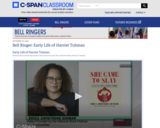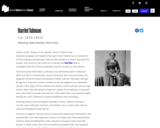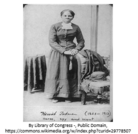
Historian Erica Armstrong Dunbar talks about the early life of Araminta Ross (Harriet Tubman).
- Subject:
- History
- Social Science
- U.S. History
- Material Type:
- Homework/Assignment
- Lecture
- Provider:
- C-SPAN
- Author:
- C-SPAN
- Date Added:
- 01/25/2023

Historian Erica Armstrong Dunbar talks about the early life of Araminta Ross (Harriet Tubman).

Harriet Tubman escaped enslavement and helped others reach freedom.
This resource is from a collection of biographies of famous women. It is provided by the National Women's History Museum, and may include links to supplemental materials including lesson plans about the subject and related topics, links to related biographies, and "works cited" pages. The biographies are sponsored by Susan D. Whiting.

Students will use their knowledge and understanding of the lives and contributions of Harriet Tubman, Frederick Douglass, and Abraham Lincoln with focus on the Civil War era by reconstructing key aspects of their lives that connect them to the Civil War.

Why is Harriet Tubman considered a hero?During this seminar, you will learn about one brave railroad conductor named Harriet Tubman. By the end of the seminar, you will identify and explain the characteristics she possessed that enabled her to save many lives. Using the complex reasoning skill of constructing support, you will relate several events from her life and experiences with the Underground Railroad to explain why Harriet Tubman is considered a hero.

During this seminar you will learn about one brave railroad conductor named Harriet Tubman. By the end of the seminar you will identify and explain the characteristics she possessed that enabled her to save many lives. Using the complex reasoning skill of constructing support, you will relate several events from her life and experiences with the Underground Railroad to explain why Harriet Tubman is considered a hero.StandardsStandard - 5.1.U.CAnalyze the principles and ideals that shape United States government.

This is intended to provide primary and secondary sources to educators as they teach the history of slavery and famous abolitionists. This is an additional resource to help students understand the humanity of slaves as smart, creative, and talented individuals. This includes primary and secondary resources inclusing examples of architecture, artwork, music, and literature.